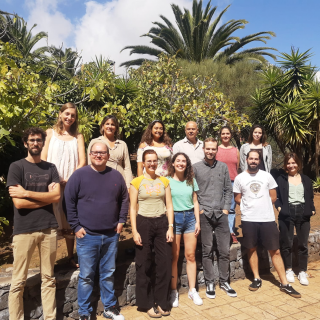Bibcode
Beasley, Michael A.; Cenarro, A. Javier; Strader, Jay; Brodie, Jean P.
Referencia bibliográfica
The Astronomical Journal, Volume 137, Issue 6, pp. 5146-5153 (2009).
Fecha de publicación:
6
2009
Número de citas
33
Número de citas referidas
30
Descripción
We report evidence for dynamically significant rotation in the globular
cluster systems of two luminous Virgo dwarf ellipticals, VCC1261 and
VCC1528. Including previous results for VCC1087, the globular cluster
systems of all three Virgo dwarf ellipticals studied in detail to date
exhibit v rot/σlos>1. Taking the rotation
seen in the globular clusters as a maximal disk rotation, and accounting
for the possible fading of any hypothetical progenitor galaxy, we find
all three dwarf elliptical galaxies (dEs) lie on the r-band Tully-Fisher
relation. We argue that these data support the hypothesis that luminous
dEs are the remnants of transformed disk galaxies. We also obtained
deep, longslit data for the stars in VCC1261 and VCC1528. Both these
galaxies show rapid rotation in their inner regions, with spatial scales
of ~0.5 kpc. These rotation velocities are surprisingly similar to those
seen in the globular cluster systems. At larger radii, we see little
rotation in the dEs themselves. Since our longslit data for Virgo dEs
extend out to 1-2 effective radii (typical of deep observations),
whereas the globular clusters extend out to 4-7 effective radii, we
conclude that nondetections of rotation in many luminous dEs may simply
be due to a lack of radial coverage in the stellar data, and that
globular clusters represent singularly sensitive probes of the dynamics
of dEs. Based on these data, we suggest that gas disks are significant
sites of globular cluster formation in the early universe.
Some of the data presented herein were obtained at the W. M. Keck
Observatory, which is operated as a scientific partnership among the
California Institute of Technology, the University of California and the
National Aeronautics and Space Administration. The Observatory was made
possible by the generous financial support of the W. M. Keck Foundation.
Proyectos relacionados

Huellas de la Formación de las Galaxias: Poblaciones estelares, Dinámica y Morfología
Bienvenida a la página web del g rupo de investigación Traces of Galaxy Formation. Somos un grupo de investigación amplio, diverso y muy activo cuyo objetivo principal es entender la formación de galaxias en el Universo de una manera lo más completa posible. Con el estudio detellado de las poblaciones estelares como bandera, estamos constantemente
Anna
Ferré Mateu